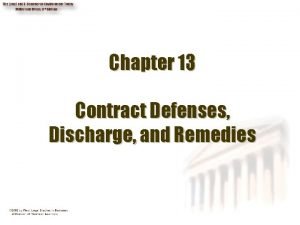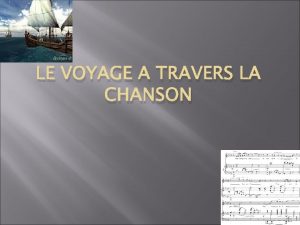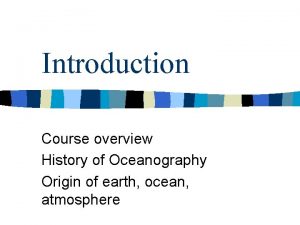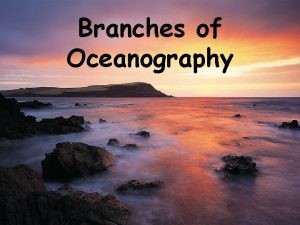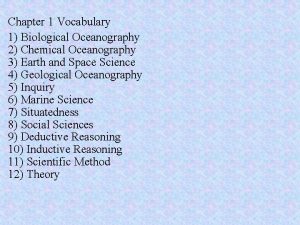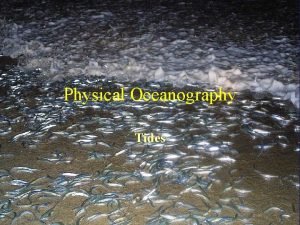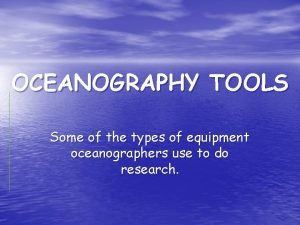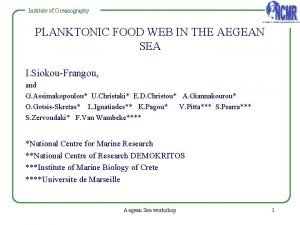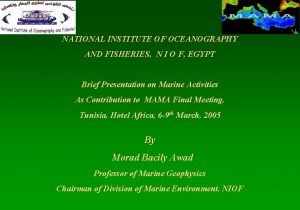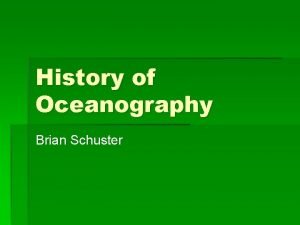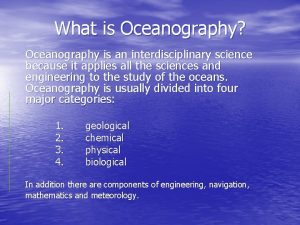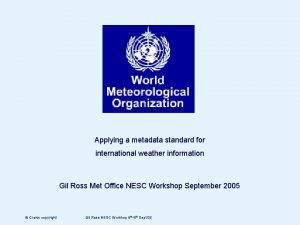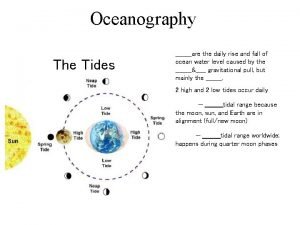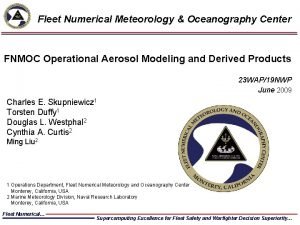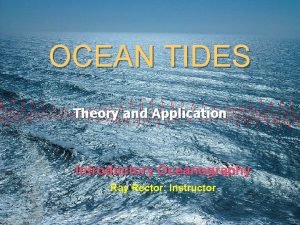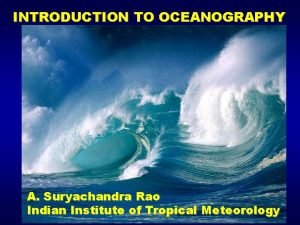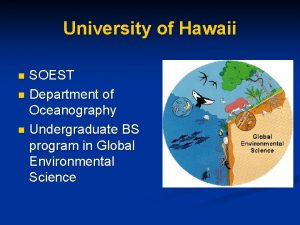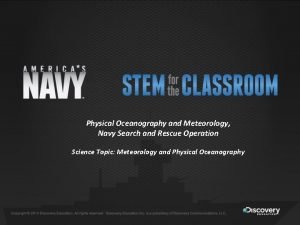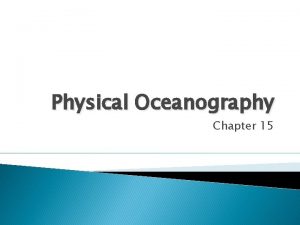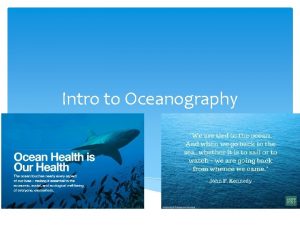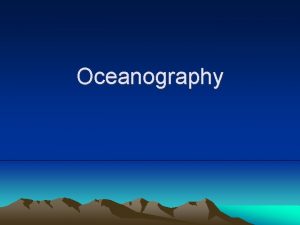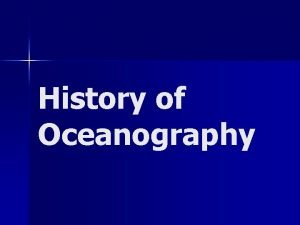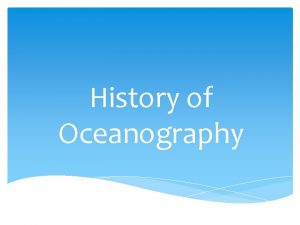History of Oceanography 4 Twentieth century oceanography Voyage






















- Slides: 22

History of Oceanography 4

Twentieth century oceanography

Voyage of the Meteor First drilling ship Ship was commissioned by Germany Set the standard for multidisciplinary studies of the Ocean. Mapped the ocean bottom by echo sounding and took multiple depth temperature and salinity readings. Meteor sailed for 25 months April 1925 to June 1927.

Oceanography gets institutionalized Musée océanographic – Europe Scripps institution of Oceanography (1 st institute in U. S. ) – California Woods Hole Ocean. Inst. (Boston) Lamont Geological Observatory - New York Rosenstiel school of Marine & Atmosphere Sciences - Miami Texas A&M University administered The Ocean Drilling Program

SCRIPPS

Woods Hole

Lamont

The expansion of oceanography German U-boat led to the invention of the echo sounder to detect submarines. WW II military performed and supported many studies on transmission of sound in the ocean waves, currents, and ocean- floor topography. After WW II the U. S. government established a Sea Grant program to fund ocean research.

Large-scale and international oceanographic research The Deep Sea Drilling Project (DSDP) was the 1 st large-scale cooperative effort in academic ocean research. The Glomar Challenger began 1 st leg of deep sea drilling. The deep sea drilling project became the ocean drilling program (ODP). The ODP drill ship JOIDES Resolution, which is a lot larger than the Glomar Challenger, conducted its first scientific cruise and the JOIDES program continues today.

The history behind plate tectonic theory In 1915, Alfred Wegener developed theory of continental drift. He conceived of a single ancient landmass called Pangaea that began to break 180 million years ago. Fredrick Vine and Drummond Matthews provided evidence for sea floor spreading in 1963 They mapped magnetic patterns of the ocean floor, which showed parallel bands of similarly magnetized reaches on either side of oceanic mountain ranges. Which were records of changes in Earth’s magnetic field over time

Humans invade the deep ocean Increased pressure on body cavities and gases dissolved in body tissues limits duration of dives. Decompressing is necessary at greater depths because rapid ascending turns dissolved gases in tissues into nitrogen. These nitrogen bubbles can stop blood flow. This is know as the bends and is extremely painful illness which can be fatal. To protect oneself, a strict decompression schedule which includes stopping at different depths Jim suit allows a person to repair machinery at the ocean floor at surface pressure

Submersibles William Beebe- descended to a depth of 923 meters off Bermuda in a tethered bathysphere to observe deep-sea life. Jacques Piccard- designed untethered vessel Trieste – 1960. Alvin, Sea Cliff- 2 most widely used submersibles. Japan’s Shinkai- to study microbes in the deep sea.

Trieste (1960) The bathyscaphe, Trieste, descends to 10, 915 meters Into Marianas Trench Deepest depth in the ocean

Submersibles Factors of manned sub: Risk to human life High cost of the systems required Relatively short time that can be spent making observations Advantages of ROVs (remotely operated vehicles) No risk to humans Can make computer-assisted maps (based on sonar) Stay down in water for a long time Autonomous Underwater Vehicles Programmed to carry out specific data gatherings missions of long durations without human life

A. U. V. s vs. R. O. V. s

Living under the sea Jacques Cousteaubegan designing and testing the underwater living chamber in the 1950 s In the 1970 s teams lived in undersea chambers for up to 60 days May be placed on ocean floor or suspended Can respond and equalize to any pressure Invented the aqualung in 1942 with co-inventor Emile Gagnon.

Aquarius Owned by NOAA and operated by FUI it is located in 60 ft of water 4. 5 Km off the coast of Key Largo, Florida.

Remote sensing Sometimes the ocean is observed from space; temp. , ice cover, color, etc. can all be measured. Seasat A - 1 st dedicated oceanographic satellite. Nimbus 7 - mapped phyto-plankton populations. TOPEX/ Poseidon- mapped global sea levels and obtained data on ocean –atmosphere interaction. Global Positioning system (GPS) - allows ships to determine their positions to with in a meter

SEASAT A

TOPEX / POSEIDON

Terms & Equipment Secchi disk- determines the transparency of water Core Sampler- takes core samples of sediments Hydrometer- determines the density of water Dredge- scoops up marine life Alvin- famous submarine that explored the deep sea

Terms & Equipment Side-scan sonar- sonar that can scan in all directions Current meter- determines the speed and direction of the current Underwater camera Flip- a bottle like vessel that can flip sideways in the water Purse seine net- used to capture schools of fish
 Parker v twentieth century fox
Parker v twentieth century fox Parker v 20th century fox
Parker v 20th century fox Voyage voyage
Voyage voyage Chanson voyage voyage
Chanson voyage voyage History of oceanography
History of oceanography Twentieth sunday after trinity
Twentieth sunday after trinity The four principle oceans of the earth are the:
The four principle oceans of the earth are the: Earth science chapter 1 vocabulary
Earth science chapter 1 vocabulary Oceanography
Oceanography Dip net oceanography
Dip net oceanography Oceanography
Oceanography Institute of oceanography and fisheries
Institute of oceanography and fisheries Polynesians oceanography
Polynesians oceanography Why is oceanography an interdisciplinary science
Why is oceanography an interdisciplinary science Chemistry oceanography
Chemistry oceanography Oceanography
Oceanography Fnmoc
Fnmoc Neap tide spring tide
Neap tide spring tide Oceanography
Oceanography Scripps institute of oceanography
Scripps institute of oceanography University of hawaii soest
University of hawaii soest Search by image
Search by image Chapter 15 physical oceanography
Chapter 15 physical oceanography
